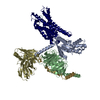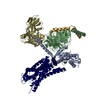[English] 日本語
 Yorodumi
Yorodumi- PDB-8xzg: Cryo-EM structure of the [Pyr1]-apelin-13-bound human APLNR-Gi complex -
+ Open data
Open data
- Basic information
Basic information
| Entry | Database: PDB / ID: 8xzg | |||||||||||||||||||||||||||||||||||||||||||||
|---|---|---|---|---|---|---|---|---|---|---|---|---|---|---|---|---|---|---|---|---|---|---|---|---|---|---|---|---|---|---|---|---|---|---|---|---|---|---|---|---|---|---|---|---|---|---|
| Title | Cryo-EM structure of the [Pyr1]-apelin-13-bound human APLNR-Gi complex | |||||||||||||||||||||||||||||||||||||||||||||
 Components Components |
| |||||||||||||||||||||||||||||||||||||||||||||
 Keywords Keywords | MEMBRANE PROTEIN / APLNR / apelin / Class A GPCR / Structural protein | |||||||||||||||||||||||||||||||||||||||||||||
| Function / homology |  Function and homology information Function and homology informationapelin receptor binding / positive regulation of corticotropin-releasing hormone secretion / positive regulation of corticotropin secretion / : / apelin receptor activity / apelin receptor signaling pathway / mechanoreceptor activity / regulation of gap junction assembly / positive regulation of G protein-coupled receptor internalization / vascular associated smooth muscle cell differentiation ...apelin receptor binding / positive regulation of corticotropin-releasing hormone secretion / positive regulation of corticotropin secretion / : / apelin receptor activity / apelin receptor signaling pathway / mechanoreceptor activity / regulation of gap junction assembly / positive regulation of G protein-coupled receptor internalization / vascular associated smooth muscle cell differentiation / atrioventricular valve development / regulation of body fluid levels / positive regulation of heat generation / venous blood vessel development / negative regulation of fibroblast growth factor receptor signaling pathway / positive regulation of heart contraction / positive regulation of cardiac muscle hypertrophy in response to stress / drinking behavior / endocardial cushion formation / positive regulation of blood vessel endothelial cell proliferation involved in sprouting angiogenesis / regulation of the force of heart contraction / coronary vasculature development / adult heart development / vasculature development / negative regulation of systemic arterial blood pressure / G protein-coupled peptide receptor activity / positive regulation of vascular endothelial cell proliferation / aorta development / negative regulation of cardiac muscle hypertrophy in response to stress / negative regulation of vasoconstriction / ventricular septum morphogenesis / blood vessel development / heart looping / negative regulation of vascular associated smooth muscle cell proliferation / positive regulation of phosphorylation / vasculogenesis / positive regulation of heart rate / adenylate cyclase inhibitor activity / positive regulation of protein localization to cell cortex / negative regulation of blood pressure / T cell migration / Adenylate cyclase inhibitory pathway / gastrulation / D2 dopamine receptor binding / response to prostaglandin E / lactation / adenylate cyclase regulator activity / G protein-coupled serotonin receptor binding / adenylate cyclase-inhibiting serotonin receptor signaling pathway / cellular response to forskolin / regulation of mitotic spindle organization / Peptide ligand-binding receptors / positive regulation of release of sequestered calcium ion into cytosol / Regulation of insulin secretion / positive regulation of cholesterol biosynthetic process / negative regulation of insulin secretion / G protein-coupled receptor binding / G protein-coupled receptor activity / response to peptide hormone / hormone activity / adenylate cyclase-inhibiting G protein-coupled receptor signaling pathway / positive regulation of miRNA transcription / adenylate cyclase-modulating G protein-coupled receptor signaling pathway / centriolar satellite / G-protein beta/gamma-subunit complex binding / Olfactory Signaling Pathway / Activation of the phototransduction cascade / G beta:gamma signalling through PLC beta / Presynaptic function of Kainate receptors / Thromboxane signalling through TP receptor / G protein-coupled acetylcholine receptor signaling pathway / positive regulation of angiogenesis / Activation of G protein gated Potassium channels / Inhibition of voltage gated Ca2+ channels via Gbeta/gamma subunits / G-protein activation / Prostacyclin signalling through prostacyclin receptor / G beta:gamma signalling through CDC42 / Glucagon signaling in metabolic regulation / G beta:gamma signalling through BTK / Synthesis, secretion, and inactivation of Glucagon-like Peptide-1 (GLP-1) / ADP signalling through P2Y purinoceptor 12 / photoreceptor disc membrane / Sensory perception of sweet, bitter, and umami (glutamate) taste / Glucagon-type ligand receptors / Adrenaline,noradrenaline inhibits insulin secretion / Vasopressin regulates renal water homeostasis via Aquaporins / GDP binding / Glucagon-like Peptide-1 (GLP1) regulates insulin secretion / G alpha (z) signalling events / cellular response to catecholamine stimulus / ADORA2B mediated anti-inflammatory cytokines production / ADP signalling through P2Y purinoceptor 1 / G beta:gamma signalling through PI3Kgamma / adenylate cyclase-activating dopamine receptor signaling pathway / Cooperation of PDCL (PhLP1) and TRiC/CCT in G-protein beta folding / GPER1 signaling / Inactivation, recovery and regulation of the phototransduction cascade / cellular response to prostaglandin E stimulus / G-protein beta-subunit binding / heterotrimeric G-protein complex Similarity search - Function | |||||||||||||||||||||||||||||||||||||||||||||
| Biological species |  Homo sapiens (human) Homo sapiens (human) | |||||||||||||||||||||||||||||||||||||||||||||
| Method | ELECTRON MICROSCOPY / single particle reconstruction / cryo EM / Resolution: 3.2 Å | |||||||||||||||||||||||||||||||||||||||||||||
 Authors Authors | Wang, W. / Ji, S. / Zhang, Y. | |||||||||||||||||||||||||||||||||||||||||||||
| Funding support |  China, 2items China, 2items
| |||||||||||||||||||||||||||||||||||||||||||||
 Citation Citation |  Journal: Cell / Year: 2024 Journal: Cell / Year: 2024Title: Structure-based design of non-hypertrophic apelin receptor modulator. Authors: Wei-Wei Wang / Su-Yu Ji / Wenjia Zhang / Junxia Zhang / Chenxi Cai / Rubi Hu / Shao-Kun Zang / Luwei Miao / Haomang Xu / Li-Nan Chen / Zongkuai Yang / Jia Guo / Jiao Qin / Dan-Dan Shen / ...Authors: Wei-Wei Wang / Su-Yu Ji / Wenjia Zhang / Junxia Zhang / Chenxi Cai / Rubi Hu / Shao-Kun Zang / Luwei Miao / Haomang Xu / Li-Nan Chen / Zongkuai Yang / Jia Guo / Jiao Qin / Dan-Dan Shen / Ping Liang / Yan Zhang / Yan Zhang /  Abstract: Apelin is a key hormone in cardiovascular homeostasis that activates the apelin receptor (APLNR), which is regarded as a promising therapeutic target for cardiovascular disease. However, adverse ...Apelin is a key hormone in cardiovascular homeostasis that activates the apelin receptor (APLNR), which is regarded as a promising therapeutic target for cardiovascular disease. However, adverse effects through the β-arrestin pathway limit its pharmacological use. Here, we report cryoelectron microscopy (cryo-EM) structures of APLNR-G complexes bound to three agonists with divergent signaling profiles. Combined with functional assays, we have identified "twin hotspots" in APLNR as key determinants for signaling bias, guiding the rational design of two exclusive G-protein-biased agonists WN353 and WN561. Cryo-EM structures of WN353- and WN561-stimulated APLNR-G protein complexes further confirm that the designed ligands adopt the desired poses. Pathophysiological experiments have provided evidence that WN561 demonstrates superior therapeutic effects against cardiac hypertrophy and reduced adverse effects compared with the established APLNR agonists. In summary, our designed APLNR modulator may facilitate the development of next-generation cardiovascular medications. | |||||||||||||||||||||||||||||||||||||||||||||
| History |
|
- Structure visualization
Structure visualization
| Structure viewer | Molecule:  Molmil Molmil Jmol/JSmol Jmol/JSmol |
|---|
- Downloads & links
Downloads & links
- Download
Download
| PDBx/mmCIF format |  8xzg.cif.gz 8xzg.cif.gz | 177.1 KB | Display |  PDBx/mmCIF format PDBx/mmCIF format |
|---|---|---|---|---|
| PDB format |  pdb8xzg.ent.gz pdb8xzg.ent.gz | 133.9 KB | Display |  PDB format PDB format |
| PDBx/mmJSON format |  8xzg.json.gz 8xzg.json.gz | Tree view |  PDBx/mmJSON format PDBx/mmJSON format | |
| Others |  Other downloads Other downloads |
-Validation report
| Summary document |  8xzg_validation.pdf.gz 8xzg_validation.pdf.gz | 392.4 KB | Display |  wwPDB validaton report wwPDB validaton report |
|---|---|---|---|---|
| Full document |  8xzg_full_validation.pdf.gz 8xzg_full_validation.pdf.gz | 403.6 KB | Display | |
| Data in XML |  8xzg_validation.xml.gz 8xzg_validation.xml.gz | 19.5 KB | Display | |
| Data in CIF |  8xzg_validation.cif.gz 8xzg_validation.cif.gz | 30.6 KB | Display | |
| Arichive directory |  https://data.pdbj.org/pub/pdb/validation_reports/xz/8xzg https://data.pdbj.org/pub/pdb/validation_reports/xz/8xzg ftp://data.pdbj.org/pub/pdb/validation_reports/xz/8xzg ftp://data.pdbj.org/pub/pdb/validation_reports/xz/8xzg | HTTPS FTP |
-Related structure data
| Related structure data |  38795MC  8xzfC  8xzhC  8xziC  8xzjC M: map data used to model this data C: citing same article ( |
|---|---|
| Similar structure data | Similarity search - Function & homology  F&H Search F&H Search |
- Links
Links
- Assembly
Assembly
| Deposited unit | 
|
|---|---|
| 1 |
|
- Components
Components
| #1: Protein | Mass: 40414.047 Da / Num. of mol.: 1 Source method: isolated from a genetically manipulated source Source: (gene. exp.)  Homo sapiens (human) / Gene: GNAI1 / Cell (production host): Sf9 / Production host: Homo sapiens (human) / Gene: GNAI1 / Cell (production host): Sf9 / Production host:  |
|---|---|
| #2: Protein | Mass: 37285.734 Da / Num. of mol.: 1 Source method: isolated from a genetically manipulated source Source: (gene. exp.)  Homo sapiens (human) / Gene: GNB1 / Cell (production host): Sf9 / Production host: Homo sapiens (human) / Gene: GNB1 / Cell (production host): Sf9 / Production host:  |
| #3: Protein | Mass: 7861.143 Da / Num. of mol.: 1 Source method: isolated from a genetically manipulated source Source: (gene. exp.)  Homo sapiens (human) / Gene: GNG2 / Cell (production host): Sf9 / Production host: Homo sapiens (human) / Gene: GNG2 / Cell (production host): Sf9 / Production host:  |
| #4: Protein/peptide | Mass: 1537.830 Da / Num. of mol.: 1 Source method: isolated from a genetically manipulated source Source: (gene. exp.)  Homo sapiens (human) / Gene: APLN, APEL / Production host: Homo sapiens (human) / Gene: APLN, APEL / Production host:  Homo sapiens (human) / References: UniProt: Q9ULZ1 Homo sapiens (human) / References: UniProt: Q9ULZ1 |
| #5: Protein | Mass: 42696.301 Da / Num. of mol.: 1 Source method: isolated from a genetically manipulated source Source: (gene. exp.)  Homo sapiens (human) / Gene: APLNR, AGTRL1, APJ / Cell (production host): Sf9 / Production host: Homo sapiens (human) / Gene: APLNR, AGTRL1, APJ / Cell (production host): Sf9 / Production host:  |
| Has ligand of interest | N |
| Has protein modification | Y |
-Experimental details
-Experiment
| Experiment | Method: ELECTRON MICROSCOPY |
|---|---|
| EM experiment | Aggregation state: PARTICLE / 3D reconstruction method: single particle reconstruction |
- Sample preparation
Sample preparation
| Component | Name: Cryo-EM structure of the [Pyr1]-apelin-13-bound human APLNR-Gi complex Type: COMPLEX / Entity ID: all / Source: RECOMBINANT |
|---|---|
| Source (natural) | Organism:  Homo sapiens (human) Homo sapiens (human) |
| Source (recombinant) | Organism:  |
| Buffer solution | pH: 7.5 |
| Specimen | Conc.: 15 mg/ml / Embedding applied: NO / Shadowing applied: NO / Staining applied: NO / Vitrification applied: YES |
| Specimen support | Grid material: GOLD / Grid mesh size: 300 divisions/in. / Grid type: Quantifoil R1.2/1.3 |
| Vitrification | Cryogen name: ETHANE |
- Electron microscopy imaging
Electron microscopy imaging
| Experimental equipment |  Model: Titan Krios / Image courtesy: FEI Company |
|---|---|
| Microscopy | Model: FEI TITAN KRIOS |
| Electron gun | Electron source:  FIELD EMISSION GUN / Accelerating voltage: 300 kV / Illumination mode: FLOOD BEAM FIELD EMISSION GUN / Accelerating voltage: 300 kV / Illumination mode: FLOOD BEAM |
| Electron lens | Mode: BRIGHT FIELD / Nominal defocus max: 2500 nm / Nominal defocus min: 1000 nm / Cs: 2.7 mm |
| Image recording | Electron dose: 62.4 e/Å2 / Film or detector model: GATAN K2 SUMMIT (4k x 4k) |
- Processing
Processing
| EM software | Name: PHENIX / Category: model refinement | ||||||||||||||||||||||||
|---|---|---|---|---|---|---|---|---|---|---|---|---|---|---|---|---|---|---|---|---|---|---|---|---|---|
| CTF correction | Type: PHASE FLIPPING AND AMPLITUDE CORRECTION | ||||||||||||||||||||||||
| Particle selection | Num. of particles selected: 2703505 | ||||||||||||||||||||||||
| 3D reconstruction | Resolution: 3.2 Å / Resolution method: FSC 0.143 CUT-OFF / Num. of particles: 201936 / Symmetry type: POINT | ||||||||||||||||||||||||
| Refine LS restraints |
|
 Movie
Movie Controller
Controller


















 PDBj
PDBj





























